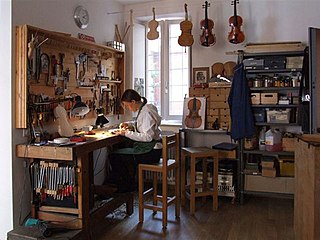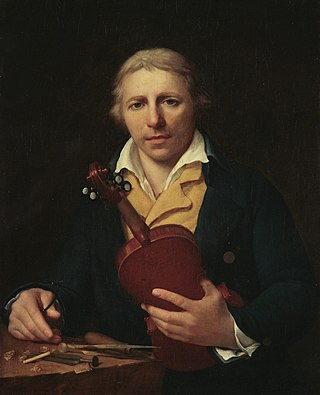Simon Straub (1662 - 1730) was a German violin maker and luthier. He was born in Friedenweiler and spent most of his life in Langenordnach.
Simon Straub is considered one of the most significant violin makers of the Alemannische Schule (Alemannic school) in Black Forest. He was a member of the Straub-Dynasty, a family of luthiers for 9 generations. One of his violins was used by Ludwig van Beethoven and is part of the Beethoven House exhibition.

A luthier is a craftsperson who builds or repairs string instruments that have a neck and a sound box. The word "luthier" is originally French and comes from the French word for lute. The term was originally used for makers of lutes, but it came to be used already in French for makers of most bowed and plucked stringed instruments such as members of the violin family and guitars. Luthiers, however, do not make harps or pianos; these require different skills and construction methods because their strings are secured to a frame.

Jean-Baptiste Vuillaume was a French luthier, businessman, inventor and winner of many awards. His workshop made over 3,000 instruments.
Jacob Stainer was the earliest and best known Austrian and Germanic luthier. His violins were sought after by famous 17th- and 18th-century musicians and composers including Johann Sebastian Bach, Wolfgang Amadeus Mozart and George Simon-Lohein.

The violin, viola and cello were first built in the early 16th century, in Italy. The earliest evidence for their existence is in paintings by Gaudenzio Ferrari from the 1530s, though Ferrari's instruments had only three strings. The Académie musicale, a treatise written in 1556 by Philibert Jambe de Fer, gives a clear description of the violin family much as we know it today.

Gagliano is the name of a famous family of Italian luthiers from Naples, dating back to the early 18th century. The Gagliano dynasty – particularly Alessandro, Nicolò I and Gennaro – are considered the high point of Neapolitan violin making. There are as many as eighteen Gagliano violin makers known worldwide today. Below is a family tree of a few of its most recognizable luthiers.
Straub is a Germanic surname that literally means "one with bushy or bristly hair". Its original meaning in Middle High German is "rough" or "unkempt". It may also refer to people who come from Straubing in Germany. Spelling variations of Straub include Straube, Strauber, Straubinger, Strauble, Strob, Strobel, Strube, Strub, Strufe, Struwe, and Struwing.

Matteo Goffriller (1659–1742) was a Venetian luthier, particularly noted for the quality of his cellos. He was active between 1685–1735 and was the founder of the "Venetian School" of luthiers, during a time when Venice was one of the most important centers of musical activity in the world.

Giovanni Grancino (1637–1709), son of Andrea Grancino, was one of the early Milanese luthiers, and may have worked with his brother, Francesco.

Dominique Peccatte was a French luthier and above all a renowned bow maker. He was apprenticed in Mirecourt and later worked with Jean-Baptiste Vuillaume.
François Nicolas Voirin (1833–1885) was a French archetier (bowmaker), known in his time as the "Modern Tourte."
Pierre Simon, was a French archetier or musical bowmaker.

Nicolas Lupot was one of the most illustrious French luthiers of his time.
Arthur Edward Smith, known as A. E. Smith, was an English-born Australian violin and viola maker whose violins and violas are prized for their 'excellence of tone' and 'decorative elements'. According to some musicians, "it is his violas that have the greatest reputation, being easily counted amongst the greatest ever created, regardless of era or nationality."
A bow maker is a person who builds, repairs, and restores ancient or modern bows for bowed string instruments. These include violins, violas, cellos, double basses, viola d'amore, viola da gamba, etc.
Caressa & Français was a distinguished firm in Paris that specialized in fine musical instruments and bows.

Nicola Amati, Nicolò Amati or Nicolao Amati was an Italian master luthier from Cremona, Italy. Amati is one of the most well-known luthiers from the Casa Amati. He was the teacher of illustrious Cremonese School luthiers such as Andrea Guarneri and Giovanni Battista Rogeri. While no clear documentation exists for their being apprentices in his shop, Amati may also have apprenticed Antonio Stradivari, Francesco Rugeri, and Jacob Stainer, as their work is heavily influenced by Amati.
The Universal Dictionary of Violin & Bow Makers is a widely cited reference work providing information on approximately 9,000 violin makers. The work is based on the extensive notes of violinist and composer William Henley (1874-1957). Henley had in his youth studied with August Wilhelmj, and later became a professor of composition and principal of the violin at the Royal Academy in London. Having played violins from many manufacturers, Henley sought to compile a comprehensive list evaluating violin and bow makers. After Henley's death in 1957, dealer Cyril Woodcock (1897–1980) completed and published the work based on Henley's unfinished notes. The work was first published in five volumes in 1959 and 1960, and republished in a single volume in 1973.

John Delany or John Delaney was an Irish luthier and maker of violins from Dublin. His instruments have become known for their unusual labels, often expressing his nationalist ideologies for liberty and equality. Two of Delany's violins are preserved as part of a collection in the National Museum of Ireland, Dublin.
James Perry was an Irish luthier from Dublin, known for making violins, violas and cellos. His workshop was based in Kilkenny and also produced instruments such as guitars, German flutes, fifes and tenors. Perry is credited with having made over 1000 instruments. He was a brother and apprentice of Dublin luthier, Thomas Perry, and a protégé of the Ormonde family of Kilkenny Castle.
Dancla violin by Stradivari is a c. 1703 Stradivarius violin which is referred to as the "Dancla." It was made by Italian luthier Antonio Stradivari of Cremona and named after the French violinist Charles Dancla. The violin is currently owned by Landesbank Baden-Württemberg and on loan to German violinist Linus Roth.